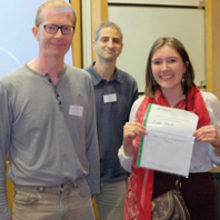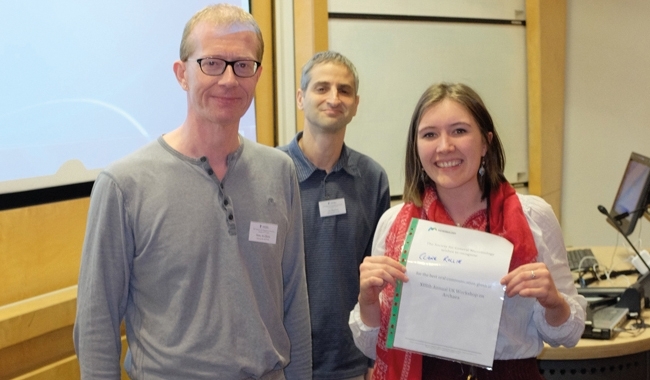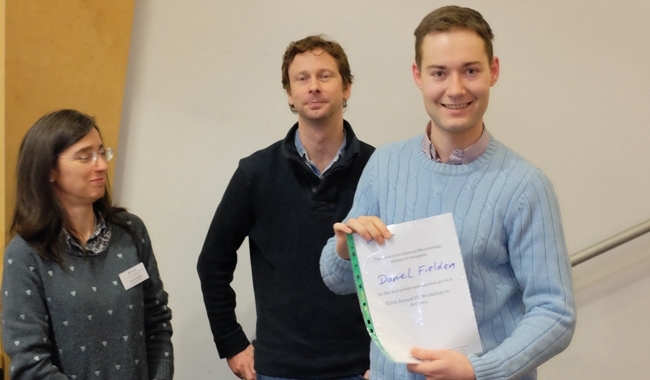XIIIth Annual UK Workshop on Archaea
11 August 2015

Since 2002, the archaeal community in the UK has held its annual workshop in January. It is convened at a different venue each year but has maintained the same format: an afternoon of talks by PhD students and young postdocs, a poster session and conference dinner, and a morning of talks. Since 2007, the UK Archaea Workshop has been generously supported by the Genetics Society and is the annual meeting of the Archaeal Sectional Interest Group.
The XIIIth Annual UK Workshop on Archaea was held 8–9 January 2015 at the Jubilee Campus of Nottingham University. Bicycle enthusiasts know that Jubilee Campus was built on the site of the old Raleigh Factory, but today it is home to the UK’s tallest freestanding artwork, some futuristic architecture, and a lake with resident geese. A total of 55 attendees from UK and continental European laboratories attended the conference. The programme of talks highlighted the research contributions of PhD and younger postdoctoral investigators in archaeal molecular biology.
The meeting kicked off with a plenary lecture by Anita Marchfelder (University of Ulm) on the Cas/CRISPR immune system of Haloferax volcanii. The remaining talks on Thursday afternoon followed the Cas/CRISPR theme, but also covered DNA replication and segregation, and the repair of double-stranded DNA breaks in Sulfolobus. The last talk on Thursday was given by Thierry Izore (MRC-LMB, Cambridge) on the structure of crenactin, an archaeal actin-like protein.
The poster session was held on Thursday evening. Topics covered included genetic and biochemical analyses of cell surface structures, Cas/CRISPR, DNA replication and repair, transcription and non-coding RNAs. The archaeal halophiles and hyperthermophiles were well represented, in particular Haloferax volcanii and Sulfolobus acidocaldarius. The conference meal was held in central Nottingham, where the scientific discussion continued late into the night.
Friday morning saw two talks on transcription and the role of RNA polymerase subunits shared by eukaryotes and archaea, followed by two talks on alcohol dehydrogenase from halophilic archaea. After the coffee break, the analysis of gene regulatory networks in Pyrococcus and the genome plasticity of Themococcus were presented. The final talk of the workshop was given by Tom William (Newcastle University), who gave a fascinating insight into the dark art of phylogenomics, and how evidence is mounting that eukaryotes originated from within the archaeal domain.
It was the unanimous decision of the judges that the Microbiology Society prize for best student talk be awarded to Clare Rollie (University of St Andrews), and the Society prize for best student poster to Daniel Fielden (University College London). The title of Clare’s talk was ‘CRISPR adaptation in Sulfolobus solfataricus’ and Daniel’s poster was on ‘The search for anti-termination complexes in archaea’.


As in previous years, the conference provoked scientific debate and stimulated new collaborations. We are very grateful to the Genetics Society for their considerable support as well as to our industrial sponsors Bioline, Alpha Laboratories, Eppendorf, Eurofins Genomics, Starlab, Electrolab, Promega, SLS, New England Biolabs, Speedy Breedy, and Bactevo. For the award of prizes for the best student talk and best student poster, we thank the Microbiology Society.
The next UK Workshop on Archaea will be at the University of Cambridge in January 2017 and will be hosted by Nick Robinson. The UK Workshop will not take place in 2016; instead the annual meeting of the Archaeal Sectional Interest Group will form part of the Molecular Biology of Archaea 5 international conference (MBoA5), which takes place in London in August 2016. The MBoA5 meeting is being organised by Thorsten Allers and Malcolm White, and is supported by the Microbiology Society and the Genetics Society.
THORSTEN ALLERS & EDWARD BOLT
School of Life Sciences, University of Nottingham, Queen’s Medical Centre, Nottingham NG7 2UH, UK


